An In-Situ Electroplating Fabricated Fabry-Perot Interferometric Sensor and Its Temperature Sensing Characteristics
Abstract
1. Introduction
2. Experiment
2.1. EFPI Sensor Structure
2.2. Preparation of EFPI Sensor
2.3. In-Situ Electroplating
2.4. Temperature Sensing Experiment
3. Results and Discussions
3.1. Spectral Characteristics of EFPI Sensors during the In-Situ Electroplating Process
3.2. Spectral Characteristics of the EFPI Sensors during the Temperature Sensing Process
3.3. Temperature Sensitivities of EFPI Sensors
4. Conclusions
Author Contributions
Funding
Conflicts of Interest
Nomenclatures
References
- Xiao, H.; Deng, J.; Pickrell, G.; May, R.; Wang, A. Single-crystal sapphire fiber-based strain sensor for high-temperature applications. J. Light. Technol. 2003, 21, 2276–2283. [Google Scholar] [CrossRef]
- Yan, L.; Gui, Z.; Wang, G.; An, Y.; Gu, J.; Zhang, M.; Liu, X.; Zhibin, W.; Wang, G.; Jia, P. A micro bubble structure based fabry-perot optical fiber strain sensor with high sensitivity and low-cost characteristics. Sensors 2017, 17, 555. [Google Scholar] [CrossRef] [PubMed]
- Frazao, O.; Baptista, J.M.; Santos, J.L. Temperature-independent strain sensor based on a Hi-Bi photonic crystal fiber loop mirror. IEEE Sens. J. 2007, 7, 1453–1455. [Google Scholar] [CrossRef]
- Chen, Z.; Xiong, S.; Gao, S.; Zhang, H.; Wan, L.; Huang, X.; Huang, B.; Feng, Y.; Liu, W.; Li, Z. High-temperature sensor based on Fabry-Perot interferometer in microfiber tip. Sensors 2018, 18, 202. [Google Scholar] [CrossRef] [PubMed]
- Li, Q.; Lin, C.-H.; Tseng, P.-Y.; Lee, H.P. Demonstration of high extinction ratio modal interference in a two-mode fiber and its applications for all-fiber comb filter and high-temperature sensor. Opt. Commun. 2005, 250, 280–285. [Google Scholar] [CrossRef]
- Miao, Y.P.; Yao, J.Q. Temperature sensitivity of microstructured optical fiber filled with ferrofluid. Acta Phys. Sin. 2013, 62, 7. [Google Scholar]
- Li, X.; Shao, Y.; Yu, Y.; Zhang, Y.; Wei, S. A highly sensitive fiber-optic Fabry-Perot interferometer based on internal reflection mirrors for refractive index measurement. Sensors 2016, 16, 794. [Google Scholar] [CrossRef]
- Ascorbe, J.; Corres, J.M.; Arregui, F.J.; Matías, I.R. Recent developments in fiber optics humidity sensors. Sensors 2017, 17, 893. [Google Scholar] [CrossRef]
- Yoshino, T.; Sano, Y.; Ota, D.; Fujita, K.; Ikui, T.; Ohta, D.; Keiichi, F. Fiber-bragg-grating based single axial mode Fabry-Perot interferometer and its strain and acceleration sensing applications. J. Light. Technol. 2016, 34, 2241–2250. [Google Scholar] [CrossRef]
- Zhou, J.; Guo, X.; Du, C.; Cao, C.; Wang, X. A fiber optic ultrasonic sensing system for high temperature monitoring using optically generated ultrasonic waves. Sensors 2019, 19, 404. [Google Scholar] [CrossRef]
- Wang, D.-H.; Jia, P.; Wang, S.J.; Zhao, C.L.; Zeng, D.P.; Wang, H.; Li, F.Q. Tip-sensitive all-silica fiber-optic Fabry-Perot ultrasonic hydrophone for charactering high intensity focused ultrasound fields. Appl. Phys. Lett. 2013, 103, 044102. [Google Scholar] [CrossRef]
- Wang, Y.-C.; Shyu, L.-H.; Chang, C.-P. The comparison of environmental effects on michelson and Fabry-Perot interferometers utilized for the displacement measurement. Sensors 2010, 10, 2577–2586. [Google Scholar] [CrossRef] [PubMed]
- Liu, H.; Li, H.; Wang, Q.; Wang, M.; Ding, Y.; Zhu, C. Simultaneous measurement of temperature and magnetic field based on surface plasmon resonance and Sagnac interference in a D-shaped photonic crystal fiber. Opt. Quantum Electron. 2018, 50, 392. [Google Scholar] [CrossRef]
- Tao, C.; Wei, H.; Feng, W. Photonic crystal fiber in-line Mach-Zehnder interferometer for explosive detection. Opt. Express 2016, 24, 2806–2817. [Google Scholar] [CrossRef]
- Miao, Y.P.; Jin, W.; Yang, F.; Lin, Y.C.; Tan, Y.Z.; Ho, H.L. Advances in optical fiber photothermal interferometry for gas detection. Acta Phys. Sin. 2017, 66, 11. [Google Scholar]
- Fan, P.; Yan, W.; Lu, P.; Zhang, W.; Zhang, W.; Fu, X.; Zhang, J. High sensitivity fiber-optic Michelson interferometric low-frequency acoustic sensor based on a gold diaphragm. Opt. Express 2020, 28, 25238. [Google Scholar] [CrossRef]
- Zhang, F.; Xu, X.; He, J.; Du, B.; Tang, J. Highly sensitive temperature sensor based on a polymer-infiltrated Mach-Zehnder interferometer created in graded index fiber. Opt. Lett. 2019, 44, 2466–2469. [Google Scholar] [CrossRef]
- Sun, L.-P.; Yuan, Z.; Huang, T.; Sun, Z.; Lin, W.; Huang, Y.; Xiao, P.; Yang, M.; Li, J.; Guan, B.-O. Ultrasensitive sensing in air based on Sagnac interferometer working at group birefringence turning point. Opt. Express 2019, 27, 29501–29509. [Google Scholar] [CrossRef]
- Domingues, M.F.; Rodriguez, C.A.; Martins, J.; Tavares, C.; Marques, C.; Alberto, N.; André, P.; Antunes, P. Cost-effective optical fiber pressure sensor based on intrinsic Fabry-Perot interferometric micro-cavities. Opt. Fiber Technol. 2018, 42, 56–62. [Google Scholar] [CrossRef]
- Hsu, J.-M.; Horng, J.-S.; Hsu, C.-L.; Lee, C.-L. Fiber-optic Michelson interferometer with high sensitivity based on a liquid-filled photonic crystal fiber. Opt. Commun. 2014, 331, 348–352. [Google Scholar] [CrossRef]
- Liang, W.; Bockrath, M.; Bozovic, D.; Hafner, J.H.; Tinkham, M.; Park, H. Fabry-Perot interference in a nanotube electron waveguide. Nat. Cell Biol. 2001, 411, 665–669. [Google Scholar] [CrossRef] [PubMed]
- Ran, Z.L.; Rao, Y.-J.; Liu, W.J.; Liao, X.; Chiang, K.S. Laser-micromachined Fabry-Perot optical fiber tip sensor for high-resolution temperature-independent measurement of refractive index. Opt. Express 2008, 16, 2252–2263. [Google Scholar] [CrossRef] [PubMed]
- Zhao, Y.; Lv, R.-Q.; Ying, Y.; Wang, Q. Hollow-core photonic crystal fiber Fabry-Perot sensor for magnetic field measurement based on magnetic fluid. Opt. Laser Technol. 2012, 44, 899–902. [Google Scholar] [CrossRef]
- Xiong, L.; Zhang, D.; Li, L.; Guo, Y. EFPI-FBG hybrid sensor for simultaneous measurement of high temperature and large strain. Chin. Opt. Lett. 2014, 12, 120605–120609. [Google Scholar] [CrossRef]
- Willshire, A.J.; Niewczas, P.; Dziuda, L.; Fusiek, G.; McDonald, J.R. Dynamic strain measurement using an extrinsic Fabry-Perot interferometric sensor and an arrayed waveguide grating device. IEEE Trans. Instrum. Meas. 2004, 53, 4–9. [Google Scholar] [CrossRef]
- Zhang, G.; Yang, M.; Wang, M. Large temperature sensitivity of fiber-optic extrinsic Fabry-Perot interferometer based on polymer-filled glass capillary. Opt. Fiber Technol. 2013, 19, 618–622. [Google Scholar] [CrossRef]
- Taylor, H.; Lee, C. Interferometric optical fiber sensors using internal mirrors. Electron. Lett. 1988, 24, 193–194. [Google Scholar]
- Wang, G. High sensitive extrinsic Fabry-Perot interferometric sensor system with low cost. Microw. Opt. Technol. Lett. 2011, 53, 1491–1493. [Google Scholar] [CrossRef]
- Deng, M.; Tang, C.-P.; Zhu, T.; Rao, Y.-J. PCF-based Fabry–Pérot interferometric sensor for strain measurement at high temperatures. IEEE Photon. Technol. Lett. 2011, 23, 700–702. [Google Scholar] [CrossRef]
- Jiang, X.; Lin, C.; Huang, Y.; Luo, K.; Zhang, J.; Jiang, Q.; Zhang, C. Hybrid fiber optic sensor, based on the Fabry-Perot interference, assisted with fluorescent material for the simultaneous measurement of temperature and pressure. Sensors 2019, 19, 1097. [Google Scholar] [CrossRef]
- Li, S.; Yu, B.; Wu, X.; Shi, J.; Ge, Q.; Zhang, G.; Guo, M.; Zhang, Y.; Fang, S.; Zuo, C. Low-cost fiber optic extrinsic Fabry-Perot interferometer based on a polyethylene diaphragm for vibration detection. Opt. Commun. 2020, 457, 124332. [Google Scholar] [CrossRef]
- Liu, P.; Jiang, L.; Wang, S.; Cao, Z. Temperature-insensitive refractive index sensor based on an optical fiber extrinsic Fabry-Perot interferometer processed by a femtosecond laser. Chin. Opt. Lett. 2016, 14, 20602–20606. [Google Scholar] [CrossRef]
- Li, Y.; Hua, Z.; Yan, F.; Gang, P. Metal coating of fiber Bragg grating and the temperature sensing character after metallization. Opt. Fiber Technol. 2009, 15, 391–397. [Google Scholar] [CrossRef]
- Li, Y.; Sun, Q.; Li, X. Real-time in situ monitoring of internal stress of the electroplating processes using FBG sensors. Appl. Phys. A 2019, 125, 823. [Google Scholar] [CrossRef]
- Chen, K.; Yang, B.; Deng, H.; Guo, M.; Zhang, B.; Yang, Y.; Liu, S.; Zhao, Y.; Peng, W.; Yu, Q. Simultaneous measurement of acoustic pressure and temperature using a Fabry-Perot interferometric fiber-optic cantilever sensor. Opt. Express 2020, 28, 15050–15061. [Google Scholar] [CrossRef]
- Liu, T.; Zhang, W.; Wang, S.; Jiang, J.; Zhang, X.; Wang, X.; Zhang, J. Temperature insensitive and integrated differential pressure sensor for liquid level sensing based on an optical fiber Fabry-Perot interferometer. IEEE Photon. J. 2018, 10, 1–8. [Google Scholar] [CrossRef]
- Zhou, K.; Ai, M.-Z.; Qian, Z.-H.; Gao, X.-X.; Hu, Z.-H.; Li, Q.; Yuan, L.; Wang, Z.; Huang, Y.-F.; Tu, T.; et al. High-sensitivity strain sensor with an in-fiber air-bubble Fabry-Perot interferometer. Appl. Phys. Lett. 2018, 113, 181901. [Google Scholar] [CrossRef]
- Chen, X.; Shen, F.; Wang, Z.; Huang, Z.; Wang, A. Micro-air-gap based intrinsic Fabry-Perot interferometric fiber-optic sensor. Appl. Opt. 2006, 45, 7760–7766. [Google Scholar] [CrossRef]
- Wei, T.; Han, Y.; Li, Y.; Tsai, H.-L.; Xiao, H. Temperature-insensitive miniaturized fiber inline Fabry-Perot interferometer for highly sensitive refractive index measurement. Opt. Express 2008, 16, 5764–5769. [Google Scholar] [CrossRef]
- Ferreira, M.S.; Roriz, P.; Bierlich, J.; Kobelke, J.; Wondraczek, K.; Aichele, C.; Schuster, K.; Santos, J.L.; Frazão, O. Fabry-Perot cavity based on silica tube for strain sensing at high temperatures. Opt. Express 2015, 23, 16063–16070. [Google Scholar] [CrossRef]
- Zinov’Ev, V. Thermophysical Properties of Metals at High Temperatures; Metallurgy: Moscow, Russia, 1989. [Google Scholar]
- Abdullaev, R.N.; Kozlovskii, Y.M.; Khairulin, R.; Stankus, S.V. Density and thermal expansion of high purity nickel over the temperature range from 150 K to 2030 K. Int. J. Thermophys. 2015, 36, 603–619. [Google Scholar] [CrossRef]
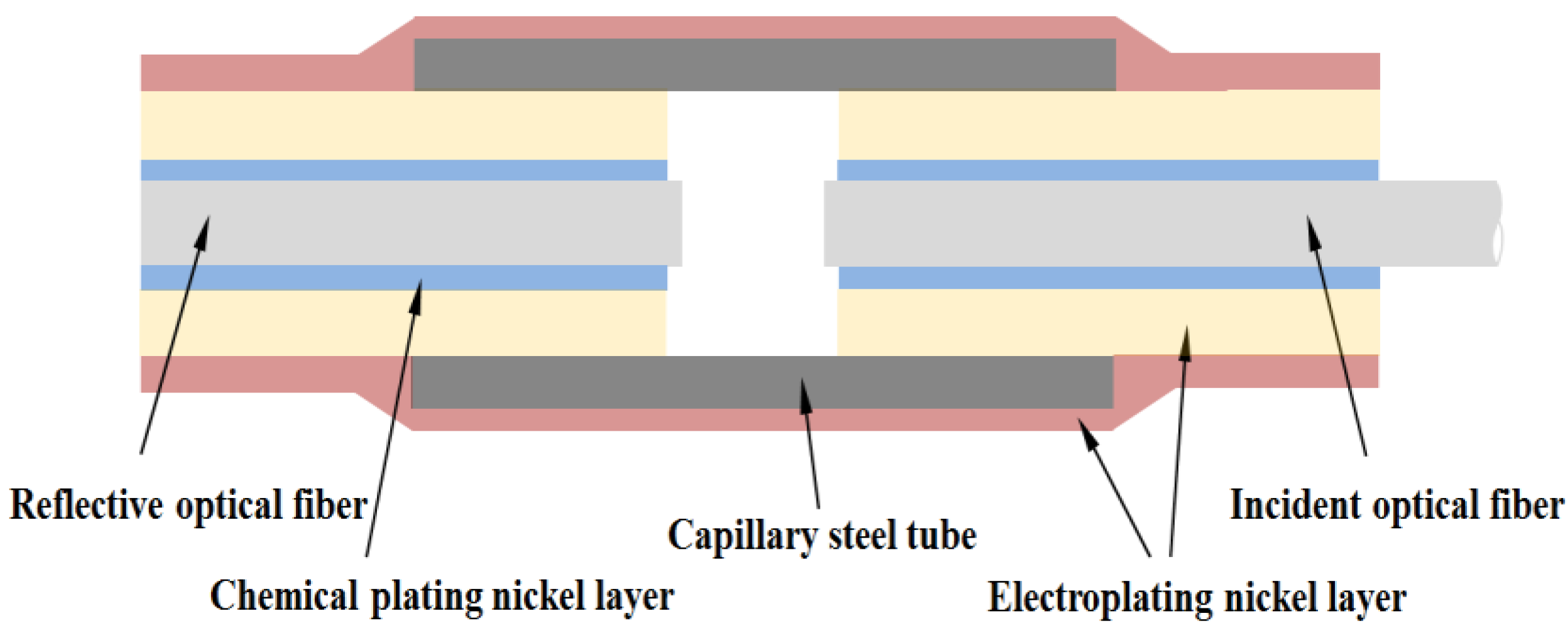

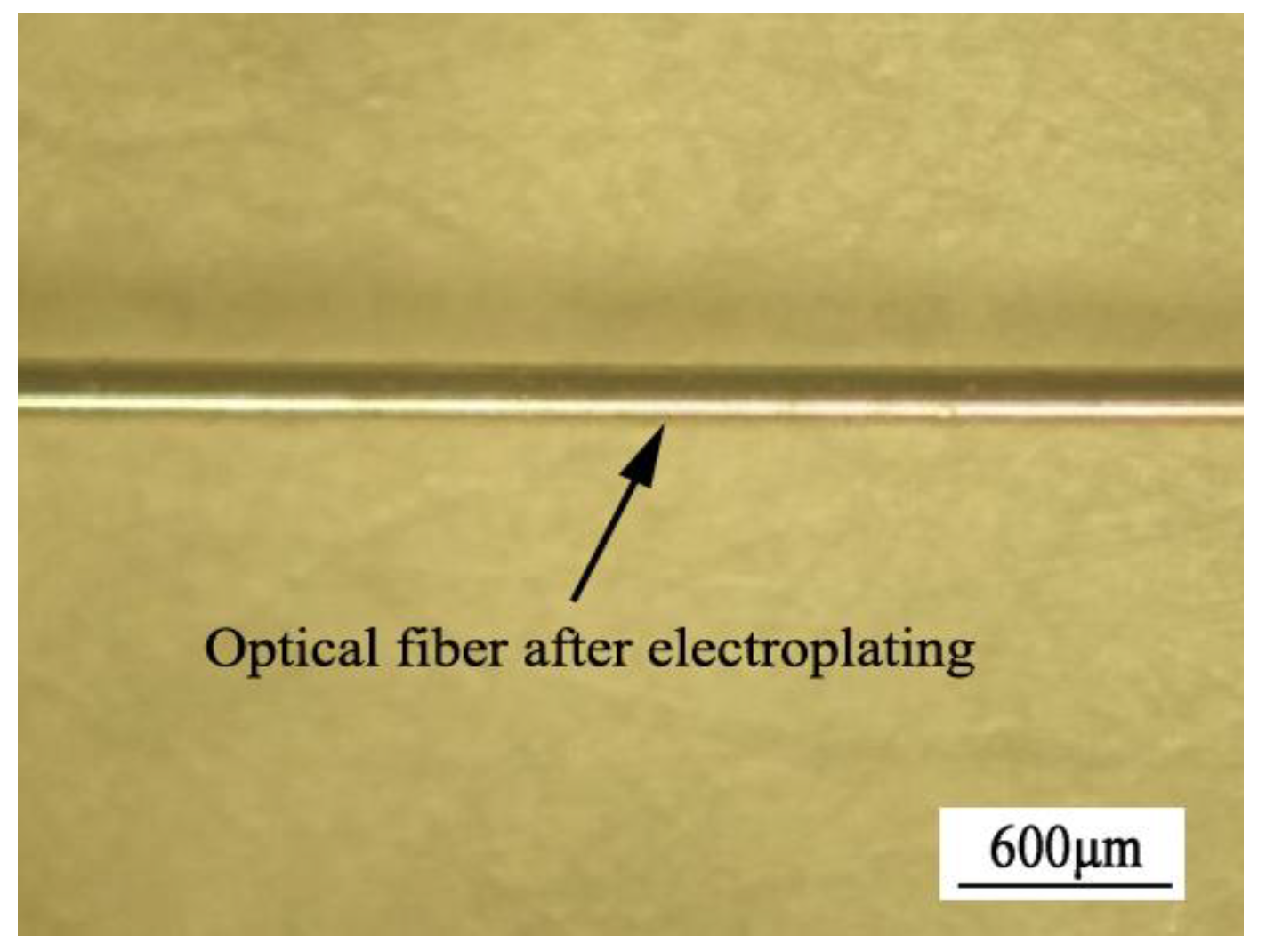
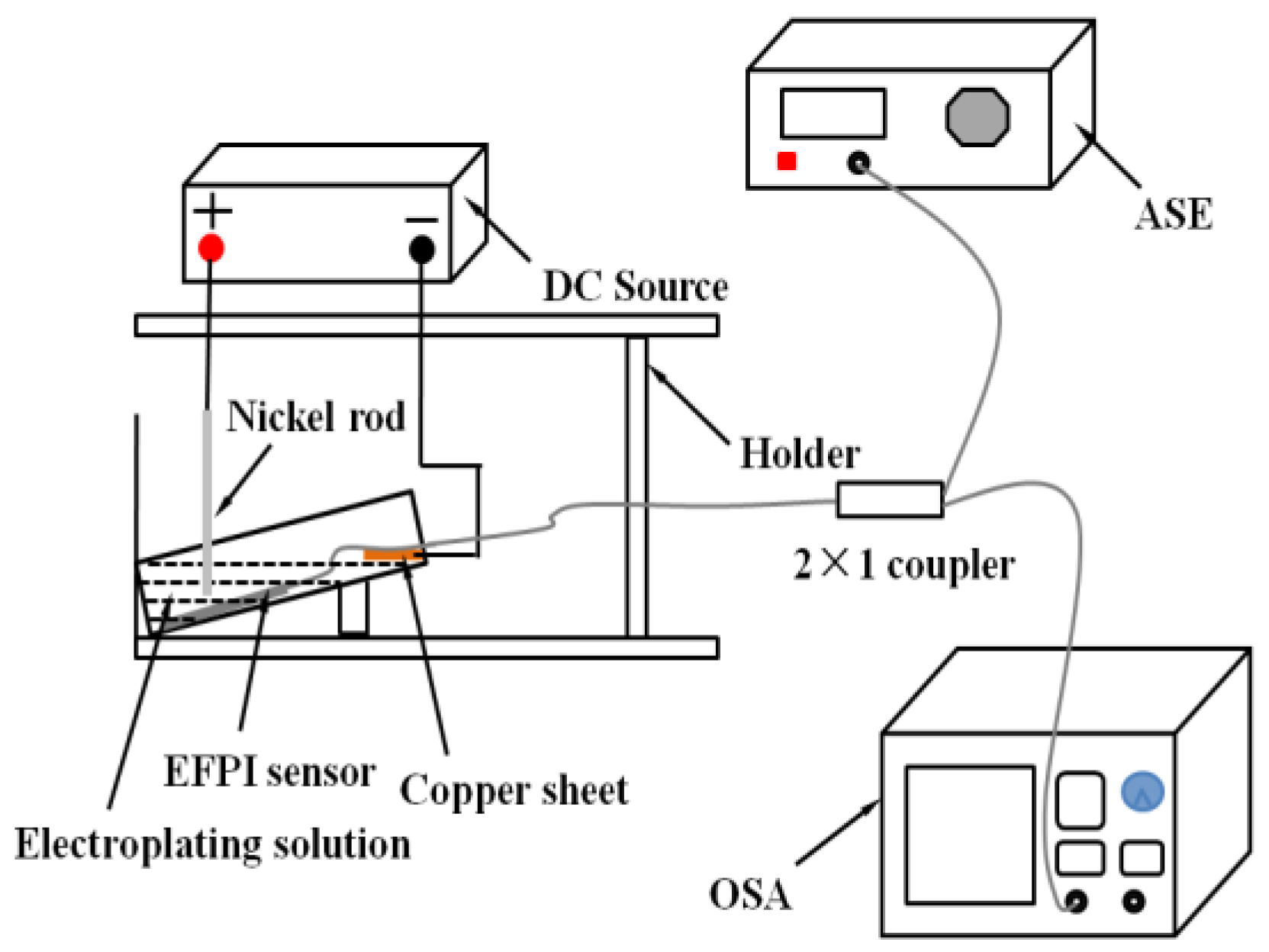
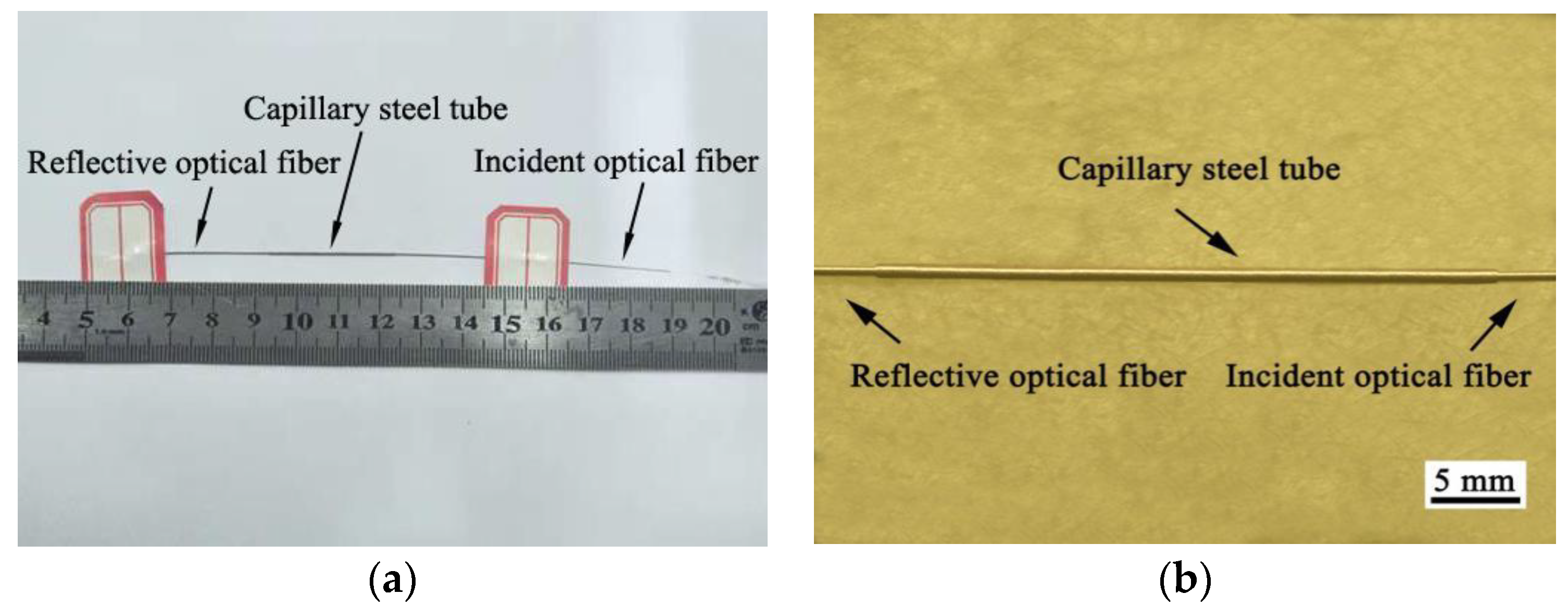

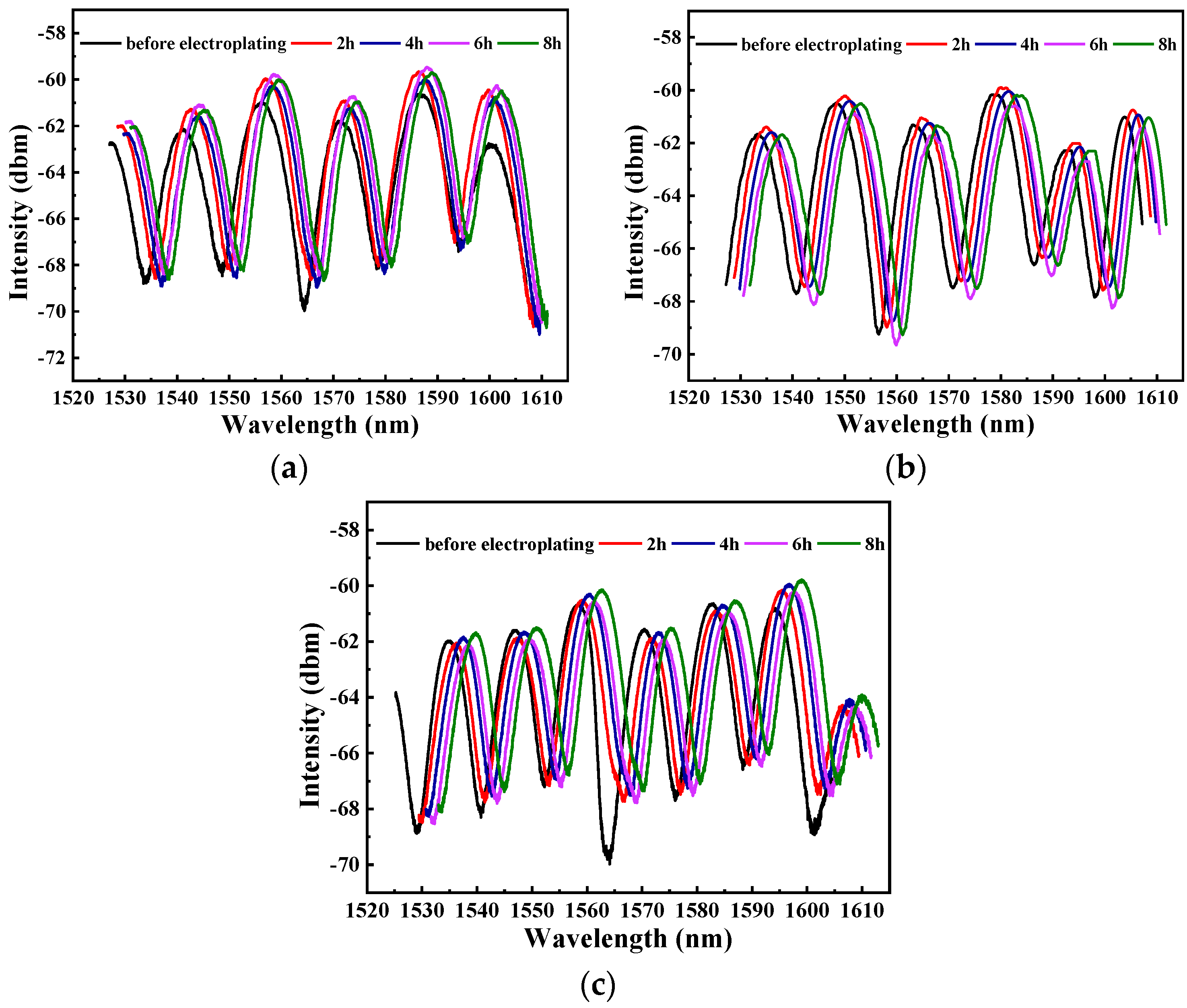

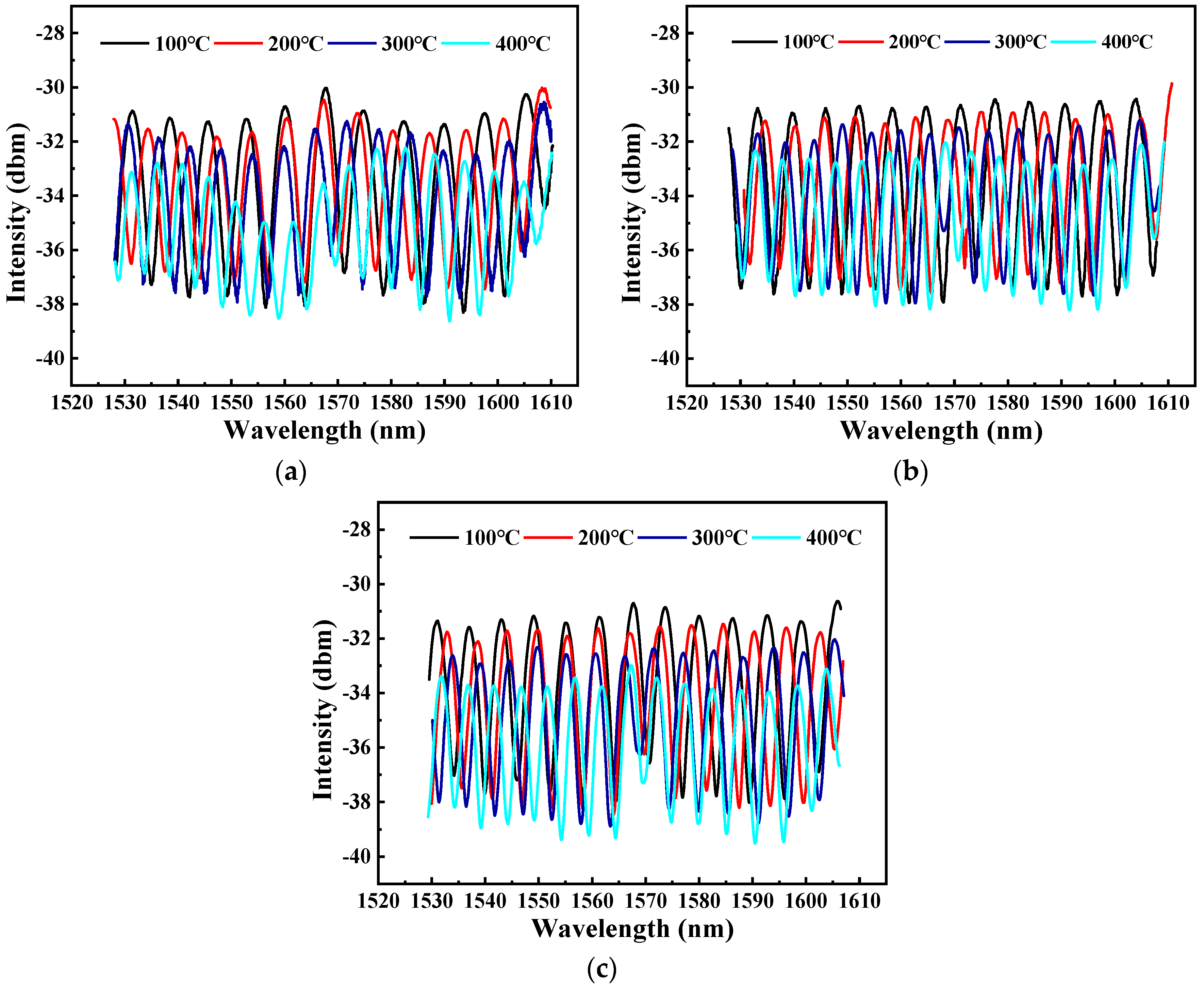

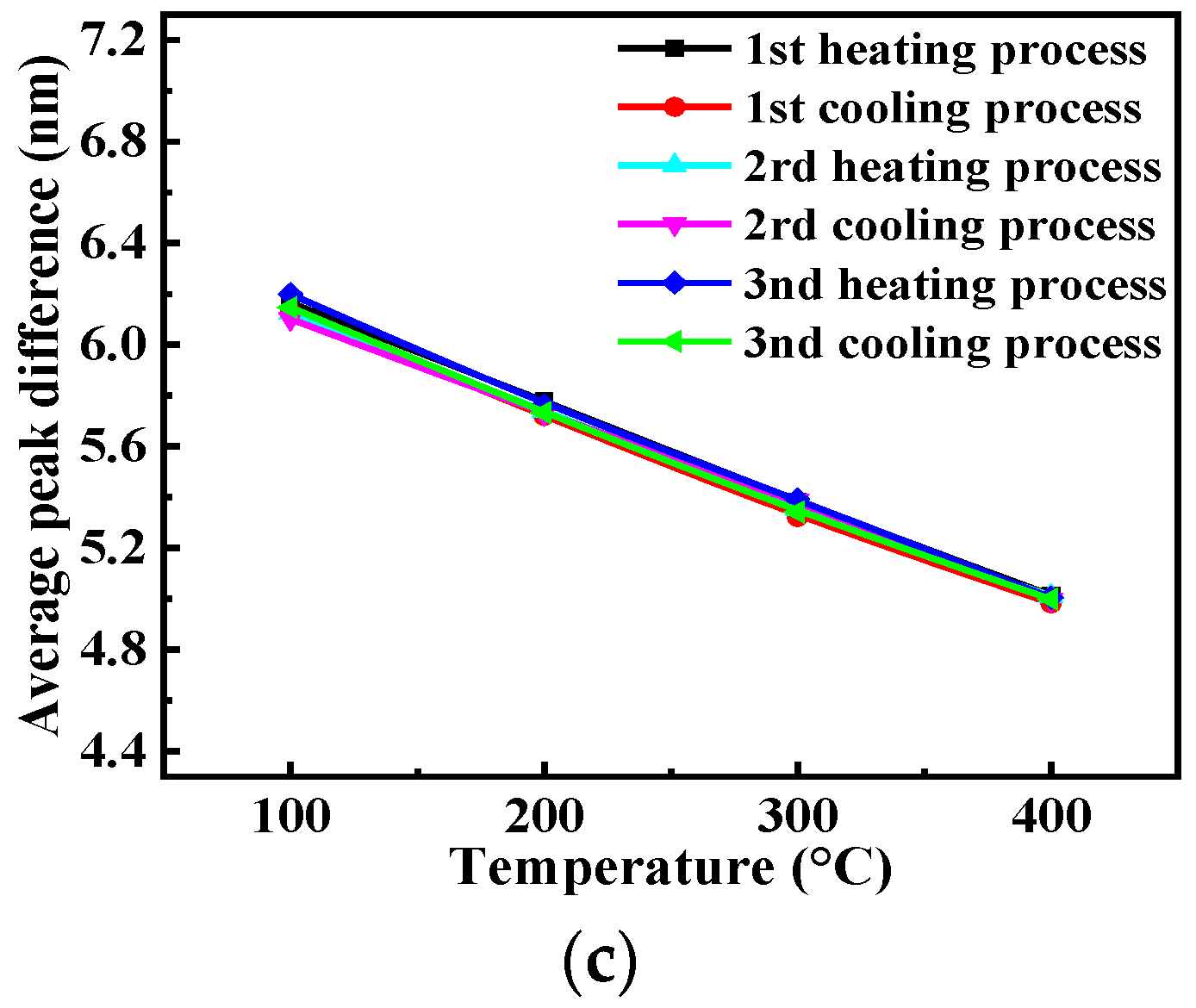
| Temperature | Test-1 | Test-2 | Test-3 | |||
|---|---|---|---|---|---|---|
| Heating Process | Cooling Process | Heating Process | Cooling Process | Heating Process | Cooling Process | |
| 100 °C | 160.420 | 160.591 | 162.052 | 160.408 | 161.878 | 160.990 |
| 200 °C | 175.830 | 175.300 | 176.669 | 176.327 | 175.078 | 174.765 |
| 300 °C | 196.801 | 196.517 | 195.787 | 195.682 | 196.476 | 195.678 |
| 400 °C | 211.743 | 210.410 | 211.848 | 210.833 | 211.273 | 210.702 |
| Temperature | Test-1 | Test-2 | Test-3 | |||
|---|---|---|---|---|---|---|
| Heating Process | Cooling Process | Heating Process | Cooling Process | Heating Process | Cooling Process | |
| 100 °C | 176.149 | 176.651 | 177.010 | 177.110 | 177.230 | 176.958 |
| 200 °C | 197.119 | 197.340 | 197.980 | 197.988 | 198.210 | 197.970 |
| 300 °C | 210.291 | 210.789 | 211.121 | 211.196 | 212.210 | 211.988 |
| 400 °C | 224.232 | 224.550 | 224.960 | 225.110 | 225.312 | 224.890 |
| Temperature | Test-1 | Test-2 | Test-3 | |||
|---|---|---|---|---|---|---|
| Heating Process | Cooling Process | Heating Process | Cooling Process | Heating Process | Cooling Process | |
| 100 °C | 191.031 | 190.845 | 191.141 | 191.246 | 192.041 | 191.822 |
| 200 °C | 203.268 | 202.227 | 203.048 | 202.602 | 202.963 | 201.856 |
| 300 °C | 215.106 | 214.613 | 215.820 | 214.470 | 216.285 | 214.991 |
| 400 °C | 231.875 | 230.390 | 231.237 | 230.551 | 231.146 | 230.878 |
| EFPI Sensor | Test-1 | Test-2 | Test-3 | |||
|---|---|---|---|---|---|---|
| Heating Process | Cooling Process | Heating Process | Cooling Process | Heating Process | Cooling Process | |
| EFPI-1 | 0.99867 | 0.99863 | 0.99796 | 0.99874 | 0.99885 | 0.99872 |
| EFPI-2 | 0.99765 | 0.99771 | 0.99852 | 0.99864 | 0.99796 | 0.99871 |
| EFPI-3 | 0.99854 | 0.99861 | 0.99864 | 0.99867 | 0.99892 | 0.99892 |
Publisher’s Note: MDPI stays neutral with regard to jurisdictional claims in published maps and institutional affiliations. |
© 2020 by the authors. Licensee MDPI, Basel, Switzerland. This article is an open access article distributed under the terms and conditions of the Creative Commons Attribution (CC BY) license (http://creativecommons.org/licenses/by/4.0/).
Share and Cite
Li, S.; Li, Y.; Liu, X.; Li, X.; Ding, T.; Ouyang, H. An In-Situ Electroplating Fabricated Fabry-Perot Interferometric Sensor and Its Temperature Sensing Characteristics. Coatings 2020, 10, 1174. https://doi.org/10.3390/coatings10121174
Li S, Li Y, Liu X, Li X, Ding T, Ouyang H. An In-Situ Electroplating Fabricated Fabry-Perot Interferometric Sensor and Its Temperature Sensing Characteristics. Coatings. 2020; 10(12):1174. https://doi.org/10.3390/coatings10121174
Chicago/Turabian StyleLi, Sijia, Yulong Li, Xubo Liu, Xuewen Li, Tao Ding, and Hua Ouyang. 2020. "An In-Situ Electroplating Fabricated Fabry-Perot Interferometric Sensor and Its Temperature Sensing Characteristics" Coatings 10, no. 12: 1174. https://doi.org/10.3390/coatings10121174
APA StyleLi, S., Li, Y., Liu, X., Li, X., Ding, T., & Ouyang, H. (2020). An In-Situ Electroplating Fabricated Fabry-Perot Interferometric Sensor and Its Temperature Sensing Characteristics. Coatings, 10(12), 1174. https://doi.org/10.3390/coatings10121174





